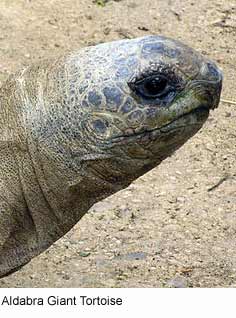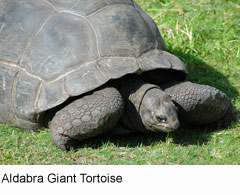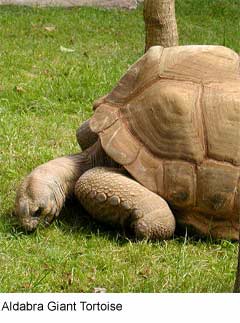|

 Just the Facts: Like its aquatic cousins, the turtle and the terrapin, the tortoise is shielded from predators by a shell. The top part of the shell is the carapace, the underside is the plastron, and the two are connected by the bridge. The tortoise has both an endoskeleton and an exoskeleton. Tortoises can vary in size from a few centimeters to two meters. Most land tortoises are herbivorous in the wild. Just the Facts: Like its aquatic cousins, the turtle and the terrapin, the tortoise is shielded from predators by a shell. The top part of the shell is the carapace, the underside is the plastron, and the two are connected by the bridge. The tortoise has both an endoskeleton and an exoskeleton. Tortoises can vary in size from a few centimeters to two meters. Most land tortoises are herbivorous in the wild.
Darwin's Tortoises: The giant tortoises of the Galápagos Islands helped Charles Darwin formulate his theory of evolution, since the isolated populations on the different islands, although descended from a common ancestor, had diverged to different forms.
Long Live the Tortoise: Tortoises generally have lifespans comparable with those of human beings, and some individuals are known to have lived longer than 150 years. Because of this, they symbolize longevity in some cultures, such as China. The oldest tortoise ever recorded, indeed the oldest individual animal ever recorded, was Tui Malila, who was presented to the Tongan royal family by the British explorer Captain Cook shortly after its birth in 1777. Tui Malila remained in the care of the Tongan royal family until its death by natural causes on May 19, 1965. This means that upon its death, Tui Malila was 188 years old, a figure that gives it the title of oldest Cheloniinae (tortoise or turtle) ever recorded.
 Dino Contemporaries: The first turtles already existed in the era of the dinosaurs, some 300 million years ago. Turtles and tortoises are the only surviving branch of the even more ancient clade Anapsida, which includes groups such as the procolophonoids, millerettids and pareiasaurs. Most of the anapsids became extinct in the late Permian period, with the exception of the procolophonoids and the precursors of the testudines (turtles and tortoises). Dino Contemporaries: The first turtles already existed in the era of the dinosaurs, some 300 million years ago. Turtles and tortoises are the only surviving branch of the even more ancient clade Anapsida, which includes groups such as the procolophonoids, millerettids and pareiasaurs. Most of the anapsids became extinct in the late Permian period, with the exception of the procolophonoids and the precursors of the testudines (turtles and tortoises).

Weights and Measures: The Aldabra Giant tortoise (Geochelone gigantea), from the islands of the Aldabra Atoll in the Seychelles, is one of the largest tortoises in the world. Similar in size to the famous Galapagos Giant Tortoise, its carapace averages 120 cm (47 in) in length. The average weight of a male is around 250 kg (551 pounds), but one male at the Fort Worth Zoological Park weighs over 360 kg (793 pounds).
 Portrait of a Tortoise: The shell is a dark gray or black color with a high domed shape. It has stocky, heavily scaled legs to support its heavy Portrait of a Tortoise: The shell is a dark gray or black color with a high domed shape. It has stocky, heavily scaled legs to support its heavy
body. The neck of the Aldabra Giant tortoise is very long, even for its great size, which helps the animal to exploit tree branches up to a meter from the ground as a food source.
What's for Dinner? Primarily herbivores, Aldabra tortoises will eat grasses, leaves, and woody plant stems. They occasionally indulge in small invertebrates and carrion, even eating the bodies of other dead tortoises. In captivity, Aldabra Giant tortoises are known to enjoy fruits such as apples and bananas as well as compressed vegetable pellets.
There is little fresh water available for drinking in the tortoises' natural habitat, therefore they obtain most of their moisture from their food.
Where in the World? The main population of the Aldabra Giant tortoise resides on the islands of the Aldabra Atoll in the Seychelles. The atoll has been protected from human influence and is home to some 152,000 giant tortoises, the world's largest population of the animal. Another isolated population of the species resides on the island of Zanzibar. The tortoises exploit many different kinds of habitat including grasslands, low scrub, mangrove swamps, and coastal dunes.
 Tortoise Turf: A peculiar kind of habitat has evolved due to the grazing pressures of the tortoises: "tortoise turf," a comingling of 21 species of grasses and herbs. Tortoise Turf: A peculiar kind of habitat has evolved due to the grazing pressures of the tortoises: "tortoise turf," a comingling of 21 species of grasses and herbs.
Many of these distinct plants are naturally dwarfed and grow their seeds not from the tops of the plants, but closer to the ground to avoid the tortoises' close cropping jaws.
Elephants with Shells: As the largest animal in its environment, the Aldabra tortoise performs a role similar to that of the elephant. Their vigorous search for food fells trees and creates pathways used by other animals.
 Tortoise Herds: Aldabra tortoises are found both individually and in herds, which tend to gather mostly on open grasslands. They are most active in the mornings when they spend time browsing for food. They dig underground burrows or rest in swamps to keep cool during the heat of the day. Tortoise Herds: Aldabra tortoises are found both individually and in herds, which tend to gather mostly on open grasslands. They are most active in the mornings when they spend time browsing for food. They dig underground burrows or rest in swamps to keep cool during the heat of the day.
Tortoise Acrobats: While they are characteristically slow and cautious, they are capable of appreciable speed, especially when tempted with a treat. They are also known to attempt perilous acrobatic feats, rising precariously on their hind legs to reach low branches. They risk death by tipping onto their backs and being unable to right themselves.
Tortoise Athletes: They are also excellent swimmers, being neutrally buoyant. This factor has allowed the spread and eventual speciation of many kinds of related tortoises across the Indian Ocean.
No Fear: The tortoises are not domestic or tame, but they are remarkably indifferent to the presence of humans. They do not seem to have any fear of people; some even seek them out for attention. Some like to have their heads patted, others enjoy having their necks scratched where they meet their plastron.

All text is available under the terms
of the GNU Free Documentation License
|